
Charles-Édouard Jeanneret, known as Le Corbusier, was a Swiss-French architect, designer, painter, urban planner and writer, who was one of the pioneers of what is now regarded as modern architecture. He was born in Switzerland and acquired French nationality by naturalization on 19 September 1930. His career spanned five decades, in which he designed buildings in Europe, Japan, India, as well as North and South America. He considered that "the roots of modern architecture are to be found in Viollet-le-Duc".

Modern architecture, also called modernist architecture, was an architectural movement and style that was prominent in the 20th century, between the earlier Art Deco and later postmodern movements. Modern architecture was based upon new and innovative technologies of construction ; the principle functionalism ; an embrace of minimalism; and a rejection of ornament.
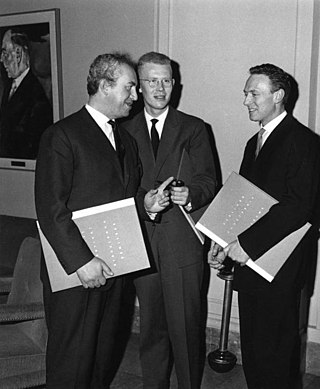
Uwe Johnson was a German writer, editor, and scholar.

The Unité d'habitation is a modernist residential housing typology developed by Le Corbusier, with the collaboration of painter-architect Nadir Afonso. It formed the basis of several housing developments throughout Europe designed by Le Corbusier and sharing the same name.
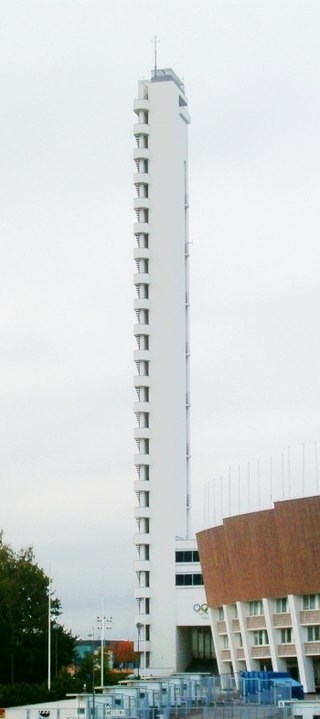
In architecture, functionalism is the principle that buildings should be designed based solely on their purpose and function. An international functionalist architecture movement emerged in the wake of World War I, as part of the wave of Modernism. Its ideas were largely inspired by a desire to build a new and better world for the people, as broadly and strongly expressed by the social and political movements of Europe after the extremely devastating world war. In this respect, functionalist architecture is often linked with the ideas of socialism and modern humanism.

Karl Philipp Moritz was a German author, editor and essayist of the Sturm und Drang, late Enlightenment, and classicist periods, influencing early German Romanticism as well. He led a life as a hatter's apprentice, teacher, journalist, literary critic, professor of art and linguistics, and member of both of Berlin's academies.

German Bestelmeyer was a German architect, university lecturer, and proponent of Nazi architecture. Most of his work was in South Germany.

The Athens Charter was a 1933 document about urban planning published by the Swiss architect Le Corbusier. The work was based upon Le Corbusier’s Ville Radieuse book of 1935 and urban studies undertaken by the Congrès International d'Architecture Moderne (CIAM) in the early 1930s.
Takamasa Yosizaka, family name also romanized as Yosizaka, was a Japanese architect and former president of the Architectural Institute of Japan and a keen mountaineer.

Charlotte Perriand was a French architect and designer. Her work aimed to create functional living spaces in the belief that better design helps in creating a better society. In her article "L'Art de Vivre" from 1981 she states "The extension of the art of dwelling is the art of living — living in harmony with man's deepest drives and with his adopted or fabricated environment." Charlotte liked to take her time in a space before starting the design process. In Perriand's Autobiography, "Charlotte Perriand: A Life of Creation", she states: "I like being alone when I visit a country or historic site. I like being bathed in its atmosphere, feeling in direct contact with the place without the intrusion of a third party." Her approach to design includes taking in the site and appreciating it for what it is. Perriand felt she connected with any site she was working with or just visiting she enjoyed the living things and would reminisce on a site that was presumed dead.

Ville radieuse was an unrealised urban design project designed by the French-Swiss architect Le Corbusier in 1930. It constitutes one of the most influential and controversial urban design doctrines of European modernism.

Spangen is a neighborhood of Rotterdam, Netherlands.
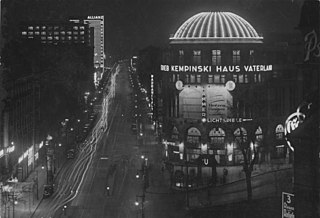
Haus Vaterland was a pleasure palace on the south-east side of Potsdamer Platz in central Berlin. Preceded by Haus Potsdam, a multi-use building including a large cinema and a huge café, from 1928 to 1943 it was a large, famous establishment including the largest cafe in the world, a major cinema, a large ballroom and numerous theme restaurants, promoted as a showcase of all nations. It was partially destroyed by fire in World War II, reopened in a limited form until 1953, and was finally demolished in 1976.

Immeuble Clarté is an apartment building in Geneva designed by Le Corbusier and Pierre Jeanneret starting from 1928 and built in 1931–32. It has eight stories comprising 45 free plan units of diverse configurations and sizes. It is one of Le Corbusier's key early projects in which he explored the principles of modernist architecture in apartment buildings, which later led to the Unité d'Habitation design principle.
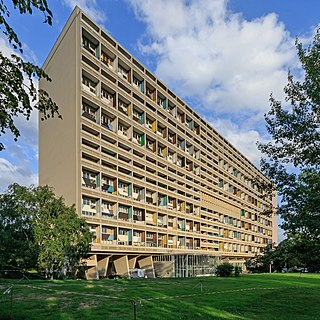
Unité d'Habitation of Berlin is a 1958 apartment building located in Berlin-Westend, Germany, designed by Le Corbusier following his concept of Unité d'Habitation. Le Corbusier's Unité d'Habitation concept was materialised in four other buildings in France with a similar design. The building is constructed in béton brut and is part of the initial architecture style we know today as brutalism. The structure was built with on site prefab cast concrete panels and poured ceiling slabs. The Modulor system is the base measure of the Unité and Corbusier used not more than 15 Modulor measures to construct the entire structure form. Ultimately the work has been eliminated from Le Corbusier's oeuvre, which he confirmed himself until his death in 1965 and which has also been confirmed posthumous in 1967 in his last authorized publication of his work.
The Axel-Springer-Preis is an annually awarded prize. The Award is given to young journalists in the categories print, TV, radio, and online journalism due to the decisions of the Axel-Springer-Akademie.

Johanna Keimeyer is a German artist. She studied art and design, both in Germany and internationally, and has worked designing lighting fixtures, as well as experimenting with different photography techniques.
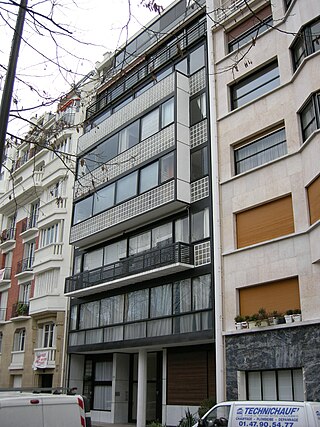
Immeuble Molitor is an apartment building designed by Le Corbusier and Pierre Jeanneret and built between 1931 and 1934. Located at the border between the city of Paris and the commune of Boulogne-Billancourt in France, it has been listed along with 16 other architectural works by Le Corbusier as a UNESCO World Heritage Site. Le Corbusier lived in the building from its completion until his death in 1965.

The Plan Voisin was a planned redevelopment of Paris designed by French-Swiss architect Le Corbusier in 1925. The redevelopment was planned to replace a large area of central Paris, on the Right Bank of the River Seine. Although it was never implemented, the project is one of Le Corbusier's most well known; its principles inspired a number of other plans around the world.
Peter Sühring is a German musicologist, publicist and music critic.
















